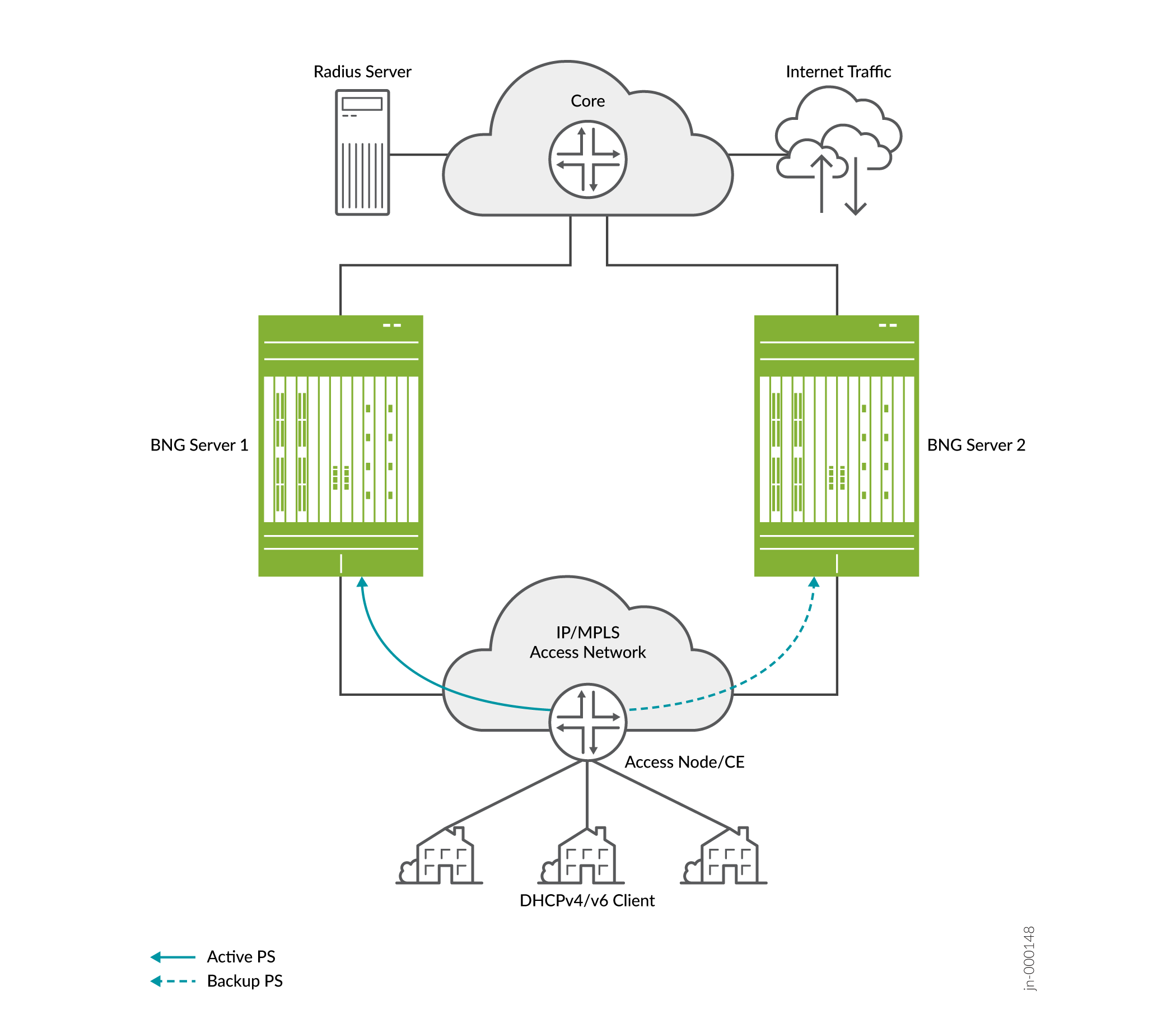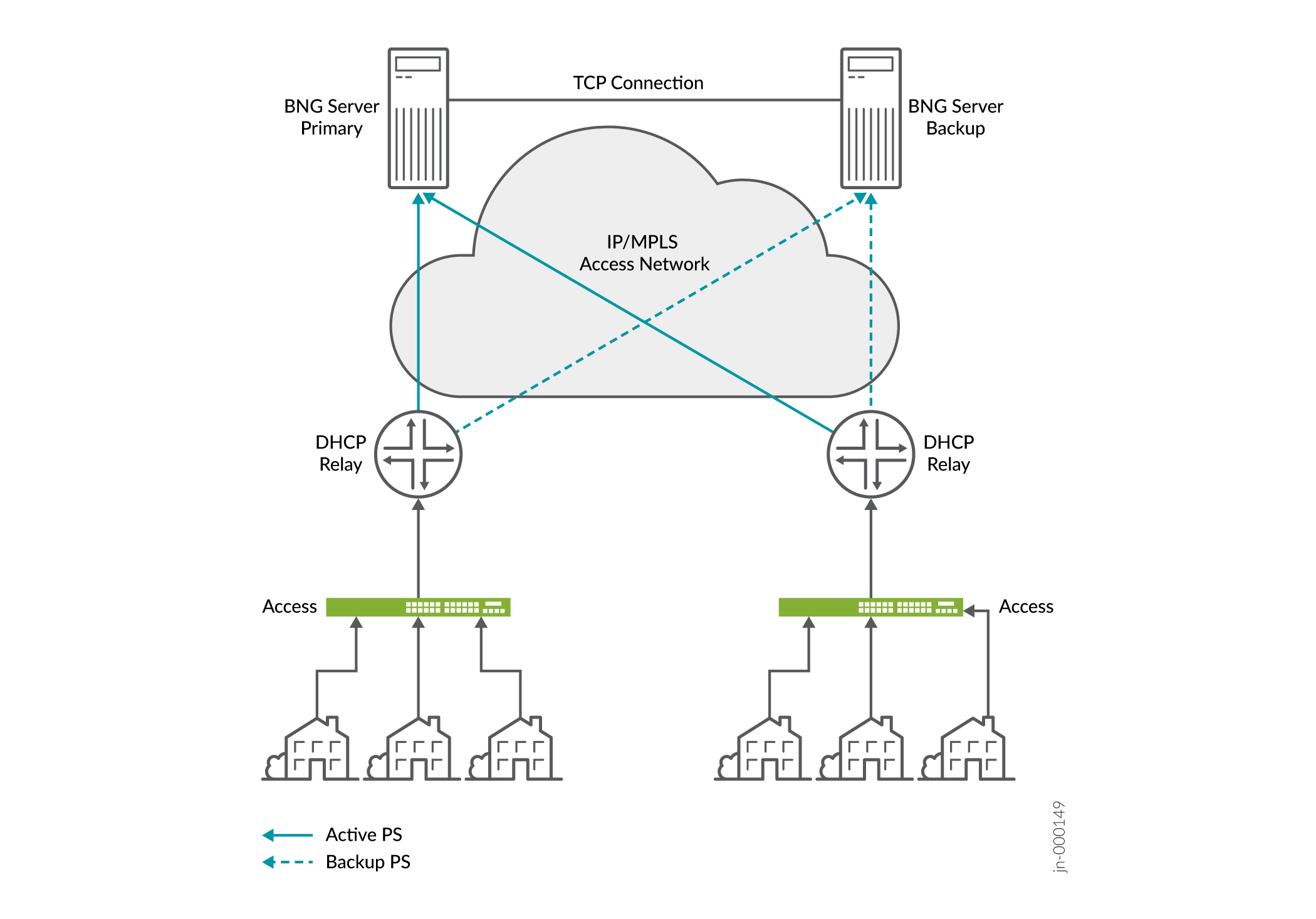M:N Subscriber Service Redundancy on DHCP Server
Learn about M:N subscriber redundancy on DHCP server, which ensures uninterrupted subscriber service.
M:N Subscriber Service Redundancy on DHCP Server Overview
You can configure M:N subscriber service redundancy on DHCP server running on MX Series broadband network gateway (BNG). DHCP server maintains considerable amount of authoritative information regarding the address it has leased to the DHCP clients. To achieve MX Series chassis level BNG redundancy for broadband subscribers, the backup MX Series device running DHCP server should possess all the subscriber authoritative information. The backup server ensures uninterrupted subscriber service when you reboot or replace the primary DHCP server, or the primary server has any hardware failures such as access link failures, access line card failure, or chassis failure.
Subscriber service redundancy on DHCP server focuses on subscriber synchronization between the peer servers using active leasequery. Live update of binding information between the two peer servers help to maintain the servers in hot standby mode.
In 1:1 subscriber service redundancy, one DHCP server (primary DHCP server) is backed up on another DHCP server (backup DHCP server) for subscriber interfaces. Both the primary and backup servers have the same set of configurations. Starting Junos OS Release 24.4R1, the chassis-based DHCP redundancy feature for MX480 access models supports 1:1 chassis-based Active Lease Query/Below Limit of Quantification (ALQ/BLQ) redundancy for non-participating underlying subscriber interfaces. This feature is supported on stacks and DHCP configurations, including BBE and non-BBE DHCP, for the following scenarios:
- Subscriber management enabled
- Subscriber management disabled
- IP Demux/ IP Demux Lite
- Dual Stack and Dual Stack single session
- Pseudo Wire Access model PS Interface (L2 Circuit / EVPN VPWS / L2VPN)
- VRRP Access model GE, XE, and AE Interfaces
- Non-default routing instance
- DHCP Relay and DHCP Server.
See Configuration Example: ALQ/BLQ for 1:1 DHCP Redundancy for details on configuration.
In M:N subscriber service redundancy multiple (M) DHCP servers (primary DHCP server)
are backed up on multiple (N) DHCP servers (backup DHCP server). To replicate the
subscribers on interface, the active leasequery uses Gi-Address
query for IPv4 and link-address query for IPv6.
When the subscribers receive the leasequery response, the relevant state machine power up the subscriber in the backup server. Then the DHCP address and lease information synchronizes between the servers. If the lease or address information changes, the backup BNG runs through the relevant state machine to power up or down the subscriber state.
Currently the subscriber services redundancy on DHCP supports pseudowire redundancy protocol. The subscriber services redundancy supports the protocols listed in Table 1.
| Supported Protocols | Subscriber Services Redundancy Mode | Additional Details |
|---|---|---|
| IPoE DHCP relay, static VLAN | M:N stateful with VRRP and active leasequery | For dynamic VLAN support must use PWHT |
| IPoE DHCP relay over PWHT | M:N stateful with active leasequery | |
| IPoE DHCP server over PWHT | M:N stateful | Include dynamic or static VLAN support |
Figure 1 shows the topology for L2 circuit based IP/MPLS PWHT in client-server mode.

Figure 2 shows the topology for L2 circuit based IP/MPLS PWHT in client-relay-server mode.

In both client-server mode and client-relay-server mode topology, BNG servers use TCP connection for active leasequery to synchronize binding details. The subscriber service redundancy on DHCP server occurs in the following order:
- Active pseudowire link receives packets from the client.
- Subscriber connects to the primary BNG.
- Primary BNG synchronizes the subscriber binding details to backup BNG using TCP connection.
- When you reboot or replace the primary BNG or the primary BNG has any chassis failure the backup pseudowire link become active.
- The backup BNG receives packets from the client.
- As backup BNG was already in hot-standby mode it can renew or rebind packets for active leasequery and synchronize subscribers as well.
For M:N subscriber service redundancy, you need to backup the subscribers interface on the backup DHCP server. The interface can have different names.
The DHCP server uses the Gi-address or link-address query to replicate the subscribers information on the backup DHCP server. In server, clients having different Gi-address or link-address comes up on single interface, thus the primary BNG should respond the query with all the subscribers having different Gi-addresses or link-address on interface. To support this functionality, the server creates a new table to store the clients based on incoming interface. When the server receives a Gi-address or link-address query, the server checks the existing server configuration. If an active leasequery configuration is available, the server responds to the query based the new database.
Active leasequery can be done between the relay to relay or server to server at any time. DHCP server may not accept connection from peer server or relay simultaneously, thus the configuration in DHCP server can be either of active-leasequery, or allow-active-leasequery, allow-bulk-leasequery, or allow-leasequery.
Benefits of M:N Subscriber Service Redundancy on DHCP Server
- Provides uninterrupted subscriber services at DHCP server level.
